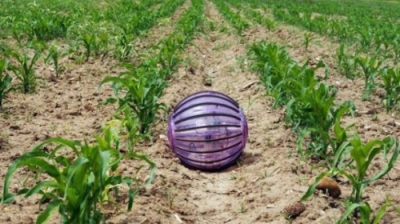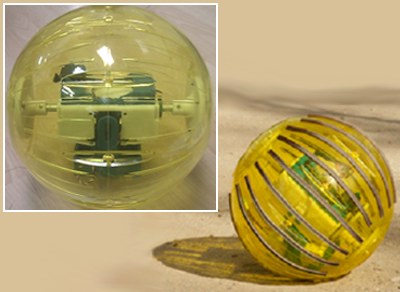A team from the Robotics and Cybernetics Research Group (Technical University of Madrid) has taken a rather curious outside-the-box and inside-a-ball approach to creating a better, more effective method for farmers to collect data on the soil conditions of their land.
Their solution?
A hamster ball.

Naturally, this is no ordinary critter carrier — in place of the tiny pet is a small group of electronics that control the direction of the ball while also acting as a swinging weight that propels the ball forward.

Internal components of the new Rosphere.
The group refers to the technology as the “Rosphere” and it was born from the need for a robotic data collection service that could easily traverse uneven terrain. Robots in the past, both with wheels as well as those with legs, have had difficulty navigating this sort of land, what with all the shifts in evenness, coupled with the lots being strewn with large and small objects for the bots to navigate around.
The Rosphere, meanwhile, is a small ball that easily rolls by all of these interferences. It does this via a control system that swings on a spindle in the center of the ball. By shifting the position of the electronics, it’s possible to make the robot roll forward. Drive wheels at both ends of the spindles are in charge of twitching the package to get the ball going and operation is done via one drive wheel, which helps the robot steer.
See it in action as it rolls across sand with relative ease:
In terms of the aforementioned electronics, the device includes an embedded computer (Gumstix) to process all of the sensor information and a 9-DOF Inertial Measurement Unit / GPS to define control actions, including position and velocity, which allows the ball to follow its predefined trajectories.
A wireless communication system is included and the ball can also be outfitted with cameras and sensors to monitor conditions like moisture levels, temperature, et cetera.

Despite its size, the Rosphere is packed with cutting-edge technology.
If, for whatever reason the farmer wishes to control the robot, he or she can do so, taking over operations from a remote location to help it get out of a ditch, untangled from some vines, or navigate around whatever obstacles happen to be in the way.
So far, the Rosphere has been tested out by rolling it along furrows between crops. The researchers hope to give it more mechanical strength so that it can take on steeper inclines, and increase its computational power for improved autonomous movement.
Story via: upm.es
Advertisement
Learn more about Electronic Products Magazine





